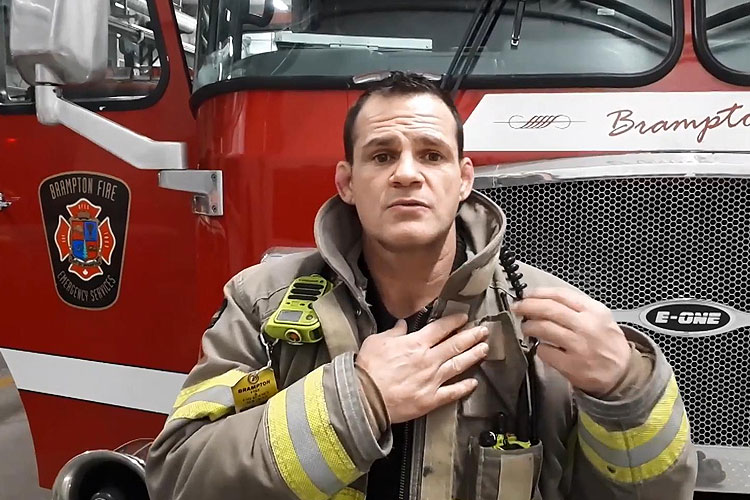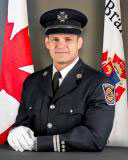
By Jared Newcombe
Applying radio best practices under warlike conditions requires an unconscious competence of skill and self-control. Stress exposure training and feedback from our peers is the catalyst to breaking old habits and committing radio best practices to muscle memory.
The firefighters and officers carrying out their tasks on the fireground are at times without visual contact. The portable radio unifies the crew. Critical information is conveyed in the form of a CANS report: Conditions found, Actions to be taken, any Needs and Safety concerns. The CANS report sets in motion the sequential operations to save life and property. The coordinated attack is a blend of science and skillfully executed actions to control the exchange of air (anti-ventilation and ventilation tactics) while advancing to confine and extinguish a fire as search teams work toward an all-clear. There are many tactical approaches that may be used to transition to an interior position, each with its own set of sequenced actions unique in their order, each action timed and communicated to make the greatest impact. Success hinges on the quality of the messages broadcasted and the understanding of those listening.
RELATED: Your Ability to Call a Mayday Depends on How You Wear Your Radio | RIT: Roof Collapse Drill
Nick Martin: Radio Tips
The International Association of Fire Chiefs (IAFC) says: “One of the review elements of any critical incident is communications effectiveness. The only way to achieve effectiveness throughout the fire service is training on what constitutes effective communications during an incident.”1
Delivering perfectly readable messages over the thunderous sound of fire apparatus and equipment is a skill, much like that of the trained ears gaining better situational awareness with each radio transmission. To ensure that messages being broadcast are intelligible, it is our responsibility to ensure we have the skills to combat various conditions under stress-full war like conditions.
Fireground communication is easier said than done, as each person’s response to stress is unique, affecting their radio skills. According to Dr. Richard Gasaway, the body’s reaction to stress is a “game changer.”2 In an eight-part series, Dr. Gasaway explores the impacts of stress, both physiological and physical. Consider adrenaline, cortisol and noradrenaline, and endorphins coursing through your veins. These may trigger auditory exclusion, hyper vigilance, tunnel senses, intuitive decision making3, and motor functions4 affected. Awareness of how stress affects performance may help us to achieve self-control, especially in the chaotic first minutes of engagement.
In applying portable radio best practices recommended by the IAFC’S Working Group5, Motorola’s positional paper on background noise6 and our departmental guidelines, our approach is broken into three phases of training, each with its own focus and goal. As we build interconnected foundations, our members develop a basic understanding of effective radio messaging. As our firefighters acquire these skills, instructors evaluate them and provide strategies to improve. Each additional phase reinforces the previous phase, and we commit radio best practices to muscle memory.
The benefits of radio messaging training under war like conditions are:
- Radio orientation for greater familiarity
- Preventing radio ejection
- Executing radio functions for various fireground conditions
- Optimal microphone positioning to ensure audio intelligibility of radio messages
- Greater overall situational awareness of how stress affects performance and self-control
Phase 1: Radio orientation for familiarity and radio ejection prevention
We ask personnel to put on their bunker coats and gloves as though they were responding to an incident. We break the group into pairs, one firefighter to demonstrate specific radio skills listed in Table A and the other to evaluate their partners’ performance before switching roles. With gloved hands and no visibility, we test the firefighter’s familiarity with their portable radio. We encourage members to paint mental pictures of fireground situations, requiring the firefighters to adjust their radio functions under specific situations: unable to transmit in the repeater position, initiating Mayday, maintaining or changing operating channels when rescue operations are underway, etc..
A great amount of discussion typically ensues after the evaluation. We discuss strategies to assist firefighters, and instructors demonstrate and coach members who may be struggling. We then repeat the exercises, usually resulting in vastly improved performance. At this point, only repeated practice will further reinforce the unconscious competence of carrying out radio skills while contending with zero visibility and the awkwardness of gloved hands, which affects manual dexterity.
RELATED: Mayday Monday: Radio Communications | IMPROVING FIREGROUND RADIO COMMUNICATIONS | The ‘Fog’ of the Fireground, Part 2: Communications on the Fireground
Radio ejection may occur when making entry through a window, bending over, or crawling during search and rescue activities. As a result, an accidental activation of the orange emergency button, taking control of talk group, the switching of fireground channels, or switching from the repeater to talk-around, may occur. To prevent radio ejection, we simply tuck the antenna under the loop above our radio pocket. Returning radios to original settings is easily remedied when skills are committed to muscle memory.
Phase 2. Audio intelligibility in high-noise environments
Focusing on the audio intelligibility of the messages delivered, we request the officer to remain in full personal protective equipment (PPE) and self-contained breathing apparatus (SCBA) and demonstrate radio messaging while breathing from their SCBA. The team will provide feedback as to the audio intelligibility of the radio transmission, taking into consideration speed, pitch, volume, and microphone positioning. Because officers are typically the instructor and evaluator, this role reversal may cause elevated heart rates and increased respirations. As the officer begins transmitting radio messages as they would on the scene, we identify any limiting actions affecting a perfectly readable message, such as:
- Positioning of microphone; under the chin, in front of regulator or just too far from voice port
- PPE neck straps covering remote microphone
- Gloved hands covering microphone
- Low pressure line limiting optimal positioning of microphone remote
- Speed, volume, rhythm of delivered messages
Firefighters identify any shortcoming with the officer’s transmission. Positioning the remote microphone without interference is often the greatest stumbling block. We suggest positioning the microphone flush to the SCBA masks voice port, then adjusting to within an inch away. The greatest success at this stage is a newly found self-awareness of how audio intelligibility is affected by positioning. Perfectly readable messages and constructive peer feedback are the catalyst to adjusting old habits and committing new habits to muscle memory.
To further reinforce the lesson, we have the officer continue with radio messaging as we introduce high decibel sounds, outlined in Table B, attempting to overpower their transmitted messages. We take this opportunity to test out both old and new habits, thereby creating contrast and awareness.

Phase 3. Delivering a message when under task and team communication
Moving with military precision and purpose is physically demanding and intense. We must still maintain multiple communications links. Officers listen to their radios for fireground information as the incident unfolds even as they simultaneously take in and disseminate the information the crew provides. Providing a CANS report is often done during battle, under task and with a heavy workload.
RELATED: Radio Communications Discipline Through C.A.R.D.S. | Preventing Rapid Intervention Company (RIC) Radio Chaos: The 3/3 Option | Radio Communications on the Fireground
To simulate this, we have the officer and a firefighter advance a hose line through to a series of designated targets, the officer making radio transmissions as they would on scene. To simulate the zero-visibility conditions of a smoke-filled environment, we have them pull the balaclavas over their masks. The team is provided with the details of an incident as though the 360 was completed by the officer leading the advancing team. Visibility is briefly introduced to allow orientation of the designated targets as the starting point to the training. The officer leading the charge will have to maintain communication with the crew but also communicate with Command as the exercise unfolds. Variables introduced may include locating victims, extreme fire behavior, and structural instability. As the audio intelligibility of the CANS report are monitored and perfectly readable, we reintroduce obstacles such as background noise, conditions requiring talk-around, or reassigned tactical radio channels.
Using tactical decision games where radio messaging is highlighted, challenges both the listening skills and adaptability of the team. The game, outlined in “Building Officers’ Thinking Skills”7, is an example of a first arriving apparatus to a structure fire, the initial deployment order to the crew and found information requiring the officer to provide a CANS report. The crew listening to their radios adjust and carry out new orders.
Radio skills training allows us to commit best practices to muscle memory, undeterred by the volatility of the fireground. Scenario-based user training leads officers and their teams down a path of further self-awareness of radio best practices under warlike conditions.
Thanks to Sean Young, Kathryn Trojan Stelmaszynski, Wesley Charlesworth, Dan Munro, Scott Pappas, William Reeves, Tricia Beirnes, and Mark Saulnier for their work in developing the radio training initiative.
REFERENCES
1. International Association of Fire Chiefs. (2008, May 22). Portable Radio Best Practices. Retrieved from https://www.iafc.org/topics-and-tools/resources/resource/portable-radio-best-practices
2. Gasaway, R. B. (n.d.). Understanding Stress – Part 1: The physical, chemical and emotional impact. Retrieved from https://www.samatters.com/understanding-stress-part-1-the-physical-chemical-and-emotional-impact/
3. Ibid.
4. Diny, M. D., Kainz, D. L., Greenhalgh, N. P., & Klemp, A. S. (2012). The Effect of Induced Stress on Fine Motor Accuracy. Retrieved from http://jass.neuro.wisc.edu/2015/01/Lab 603 Group 12.pdf
5. International Association of Fire Chiefs. (2008, May 22). Portable Radio Best Practices. Retrieved from https://www.iafc.org/topics-and-tools/resources/resource/portable-radio-best-practices
6. Background Noise and Radio Performance. (2009). Retrieved from http://brics.butlersheriff.org/wp-content/uploads/2009/04/moto-digital-fireground-whitepaper.pdf
Originally ran February 25, 2019.
 JARED NEWCOMBE is a captain and a 25-year veteran of the Brampton Fire and Emergency Services in Ontario, Canada.
JARED NEWCOMBE is a captain and a 25-year veteran of the Brampton Fire and Emergency Services in Ontario, Canada.

